02.19.11
Posted in Non-US Weather, Tropical Weather, Weather News at 8:00 am by Rebekah
Ex-Tropical Cyclone Carlos just keeps on dancing down the northwestern coast of Australia!
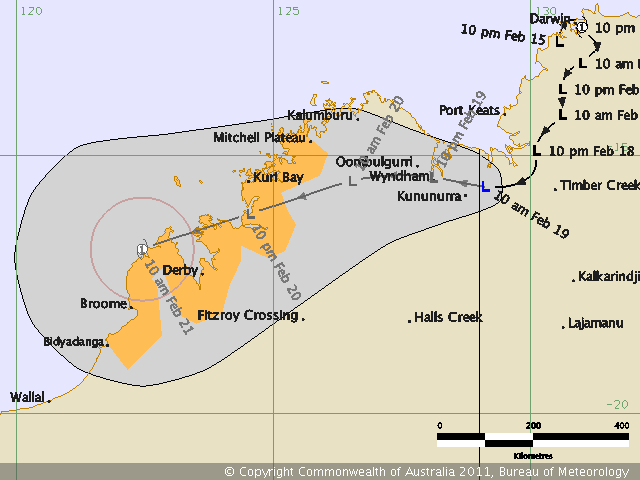
This is so strange…the tropical low was upgraded to tropical cyclone as soon as it moved OFF the coast (would that be a…waterfall? :)), then it came back onshore, swirled around Darwin and dumped over 2 feet of rain on the area in about 3 days (over half the average February rainfall). Now it’s still being recognized as a tropical low. Carlos is close to making it offshore again, but really has the best chance in a couple of days, when the low could become a Category 1 cyclone again.
Oh, and in the meantime, Category 3, Severe Tropical Cyclone Dianne is off the west coast of Australia, actually acting more in character for a tropical cyclone (well, except for the couple of little loop-de-loops the Bureau of Meteorology had her taking). Dianne isn’t expected to make landfall, but to gradually weaken.
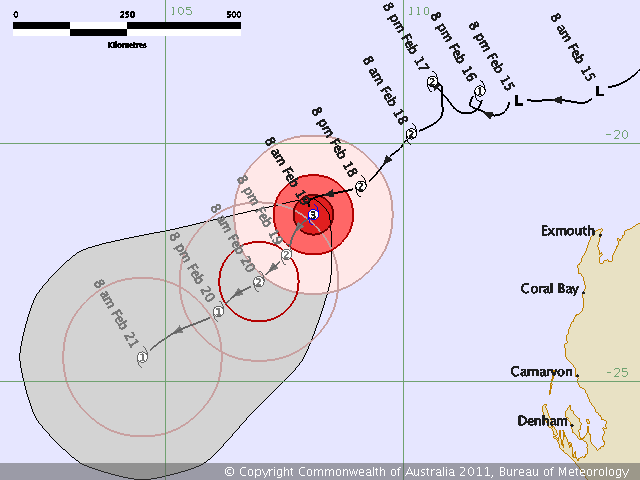
EDIT: The Bureau of Meteorology now has Carlos getting to a Category 2!
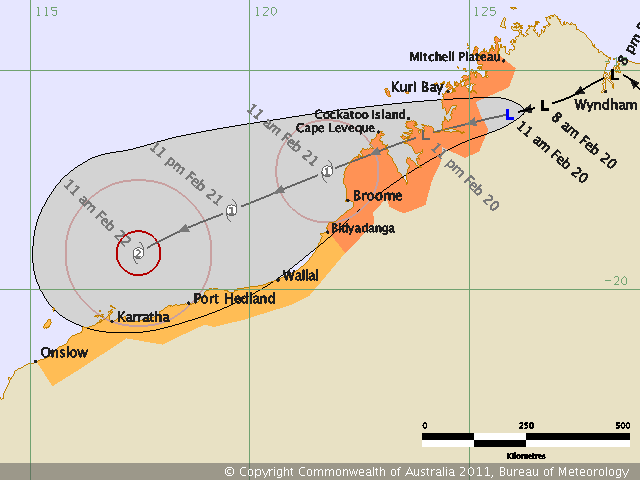
Permalink
02.17.11
Posted in Non-US Weather, Tropical Weather, Weather News at 8:00 am by Rebekah
Check this out! Isn’t the track of this low bizarre?
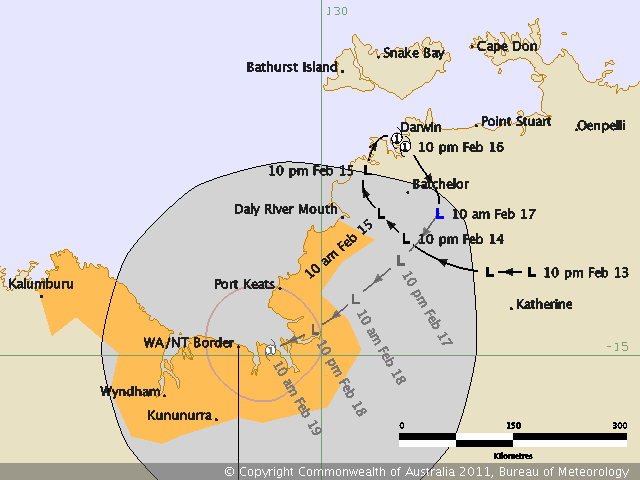
Ex-Tropical Cyclone Carlos’ path. From the Bureau of Meteorology
Darwin, Australia has received over 2 feet of rain from this system over the past 3 days or so, and the winds have toppled a number of trees!
Permalink
02.15.11
Posted in Non-US Weather, Weather News, Winter Weather at 8:00 am by Rebekah
This week’s post in the global weather and climate series features Gangneung (Kangnŭng), Gangwon-do, South Korea.
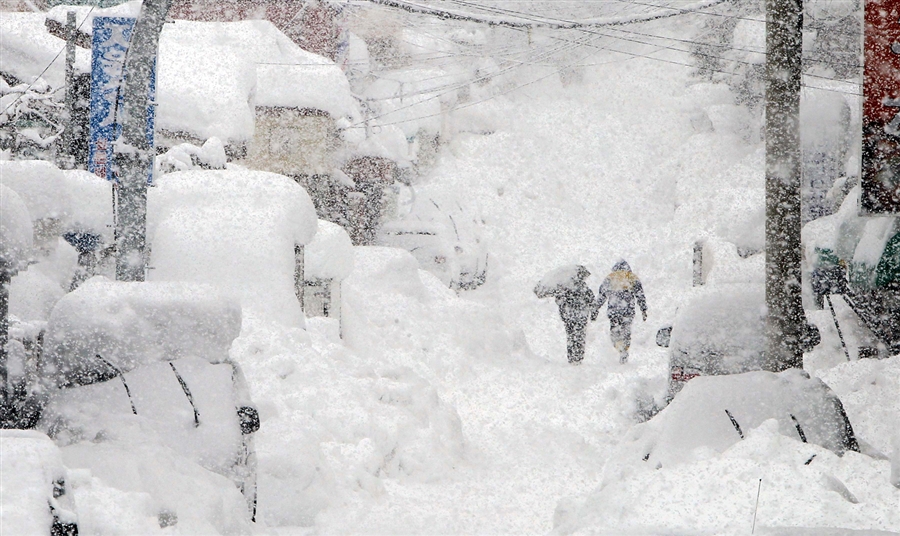
Heavy snow in Gangneung on Feb. 14, 2011. Photo by Lee Sang-hak / Yonhap via Reuters
Gangneung (Kangnŭng) is a city of about 230,000 people in Gangwon-do province, South Korea. Situated on the east coast of the country, Gangneung lies between the Sea of Japan (East Sea) and the Baekdu mountain ridge. The beautiful valleys and mountains around Gangneung, as well as the pine forests and sandy beaches, make this city a popular tourist destination. There are also many festivals that take place in Gangneung.
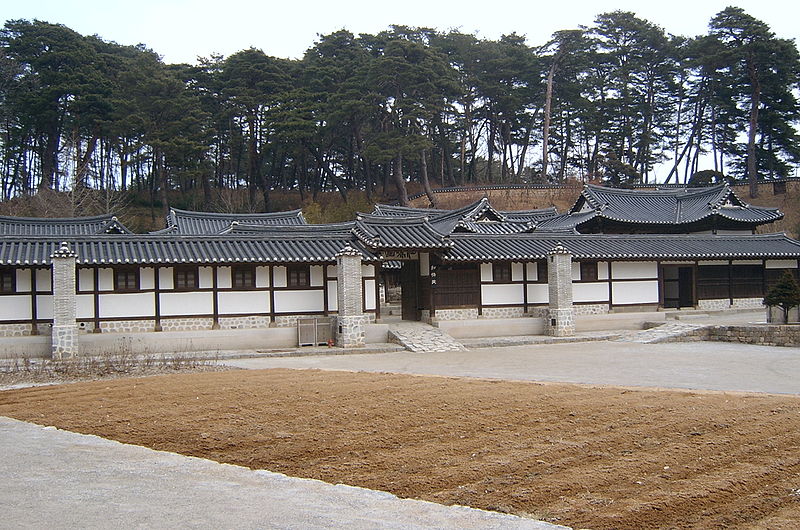
Seongyojang, a 19th century country house outside of Gangneung. From Wikipedia
A few more facts about Gangneung (from Wikipedia):
- Time zone: Korea Standard Time (UTC+9)
- Elevation: varies…from about 30 ft (9 m) to around 100 ft (30 m)…higher in the hills
- Climate zone: Humid subtropical
- Average high temperature: 63 °F (17 °C)
- Average low temperature: 48 °F (9 °C)
- Average annual high/low temperature range: 41 to 83 °F (5 to 28 °C) / 26 to 70 °F (-3 to 21 °C)
- Average annual precipitation: 55 inches (1,402 mm)
Weather: Eastern South Korea has been experiencing record snowfalls lately. Gangneung recently observed a 24-hr snowfall of 30.6 inches (77.7 cm), the greatest 24-hr snowfall since records began in 1911. This heavy snow caused hundreds of roofs to collapse and stranded cars in huge drifts of snow.
High temperatures this week are expected to be in the mid to upper 30s (°F), with lows around 20 °F. Snow is not uncommon this time of year, but this has been an uncommonly cold winter for North Korea and snowy winter for eastern South Korea. Newspapers in South Korea are calling this a “snow bomb”, similar to recent US terms popularized by the media such as “snowpocalypse” and “snowmaggedon”.
For weather maps and information on current and forecast Gangneung weather, see Weather Underground and Weather Online UK (maps and models).
For more information on Gangneung, here’s a link to Wikipedia.
Next Tuesday I plan to take a look at the climate and weather in another part of the globe. As always, if you have any suggestions for future cities, please leave a comment!
Permalink
02.13.11
Posted in Non-US Weather, Tropical Weather, Weather News at 1:20 pm by Rebekah
Intense Tropical Cyclone Bingiza (see southwest Indian Ocean ratings) now has 10-minute average sustained winds of 105 mph and a minimum pressure of 953 mb (equivalent of a Category 3 on the Saffir-Simpson Scale). The tropical cyclone is still slowly moving towards northeastern Madagascar at 5 mph, and is expected to now in about 24 hours (late Monday night local time).
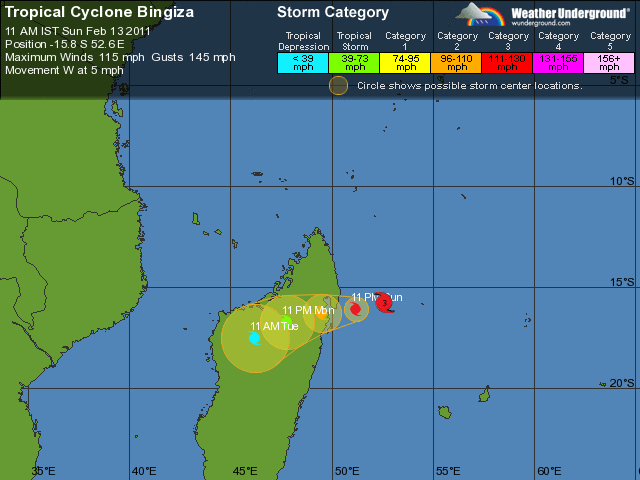
Forecast track of Tropical Cyclone Bingiza, from Weather Underground
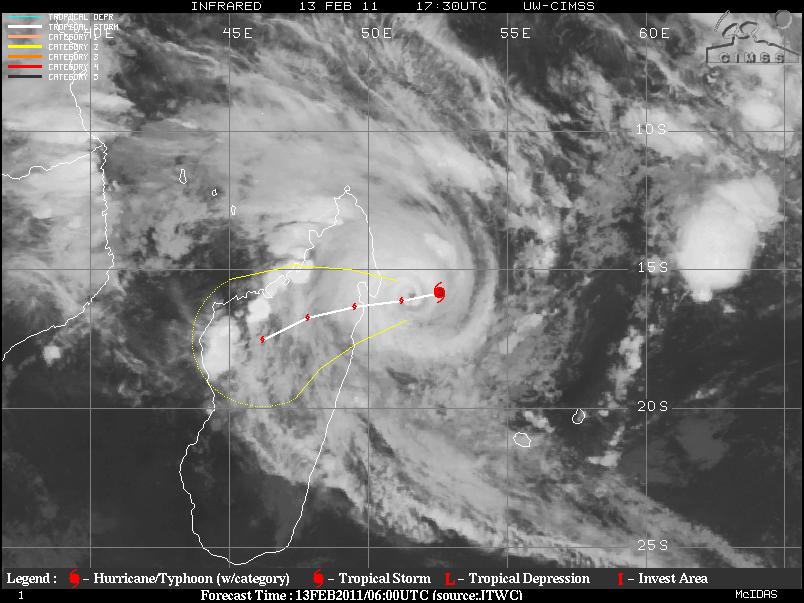
Tropical Cyclone Bingiza, from UW-CIMSS
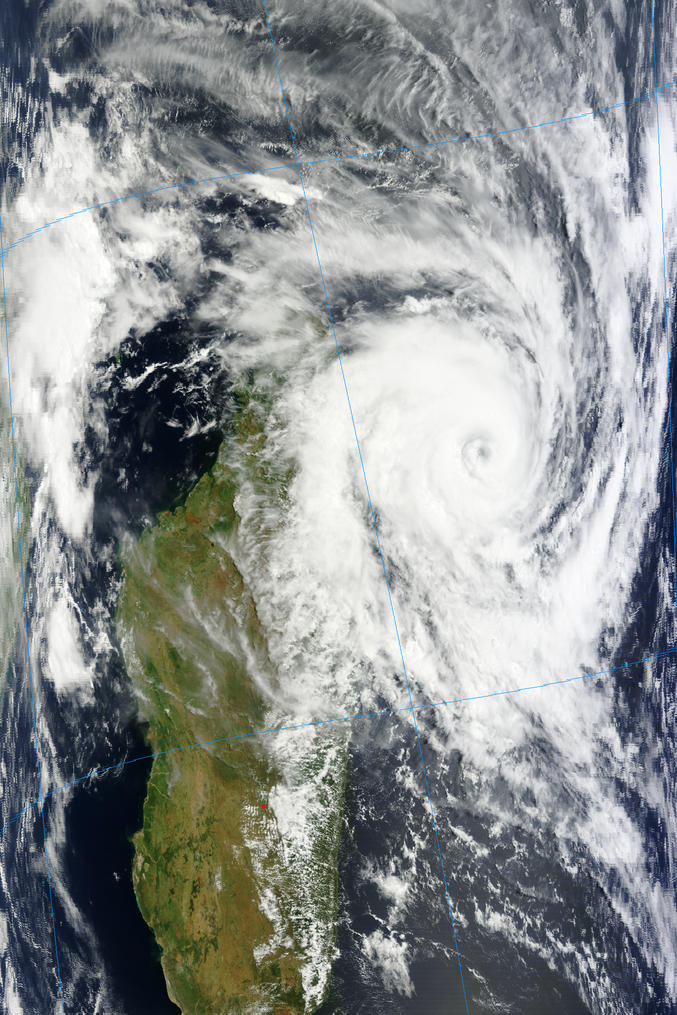
Tropical Cyclone Bingiza, from Terra/MODIS
The tropical cyclone is still headed for the farming towns of Manambolosy, Mananara Nord, and Soanierana Ivongo, as well as affect a tiny, offshore island called Île Sainte-Marie.
See also the post earlier today on Bingiza.
Permalink
Posted in Non-US Weather, Tropical Weather, Weather News at 8:00 am by Rebekah
Tropical Cyclone Bingiza, with 10-minute average sustained winds of 90 mph and a minimum pressure of 963 mb (equivalent of a Category 2 on the Saffir-Simpson Scale), is slowly inching its way towards northeastern Madagascar. The tropical cyclone is currently moving west-southwest at 3 mph.
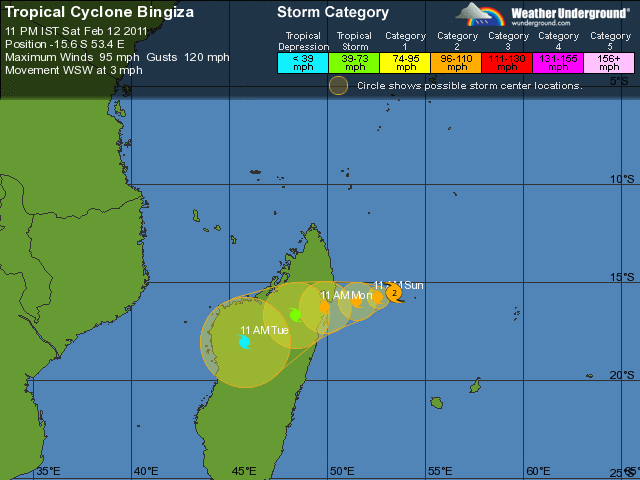
Forecast track of Tropical Cyclone Bingiza, from Weather Underground
The cyclone is expected to make landfall at about this intensity late Monday morning local time (Sunday night U.S. time).
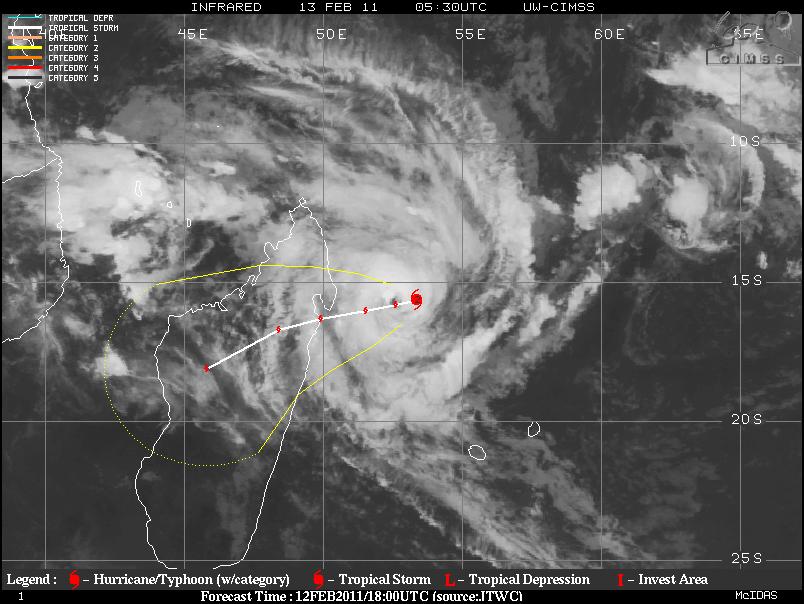
Tropical Cyclone Bingiza, from UW-CIMSS
It appears that the cyclone’s eye will make landfall near the farming towns of Manambolosy (~11,000 people), Mananara Nord (~30,000), and Soanierana Ivongo (~22,000), as well as affect a tiny, offshore island called Île Sainte-Marie (~17,000).
Madagascar is no stranger to tropical cyclones. The southwest Indian Ocean’s most intense cyclone in recorded history struck this same part of Madagascar in March 2004, causing devastating damage. Cyclone Gafilo was the equivalent of a Category 5 on the Saffir-Simpson Scale, with a minimum central pressure of 895 mb and 10-minute sustained winds of 145 mph (1-minute sustained winds of 160 mph).
To see more on different tropical cyclone rating systems in different ocean basins, see another blog post I wrote, “Tropical Cyclone Ului Makes Landfall in Australia“.
To see a recent blog post I wrote on the weather and climate of the nearby capital of Madagascar, Antananarivo, check out “World Wide Weather #25: Antananarivo, Madagascar“.
Bingiza is the fifth tropical disturbance and the second named storm of the Southwest Indian Ocean tropical cyclone season, which begun on November 15th and will run until April 30th.
Permalink
« Previous Page — « Previous entries « Previous Page · Next Page » Next entries » — Next Page »










